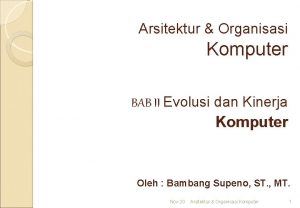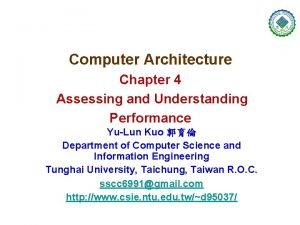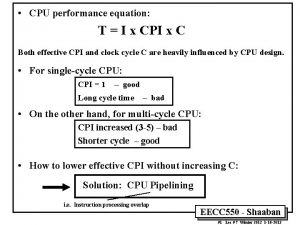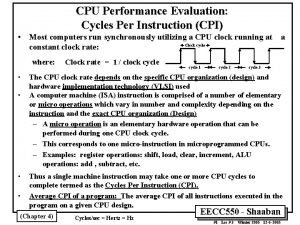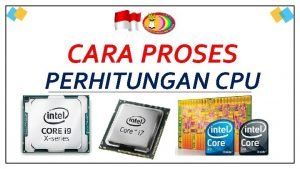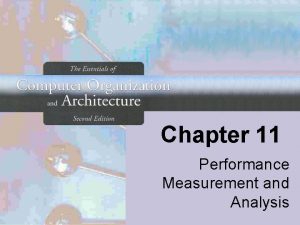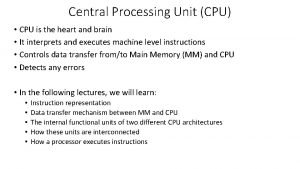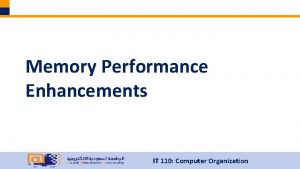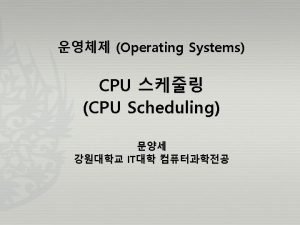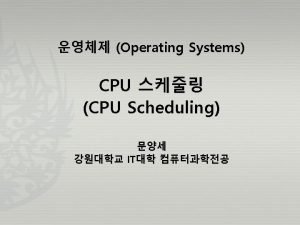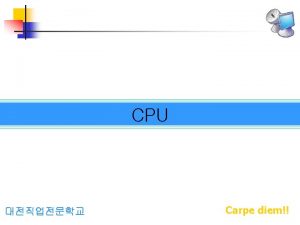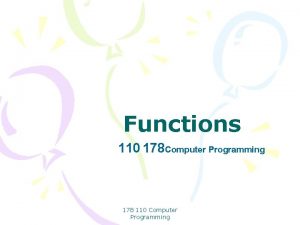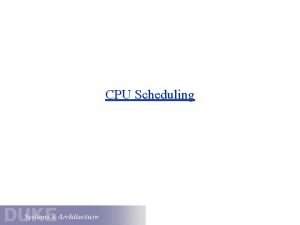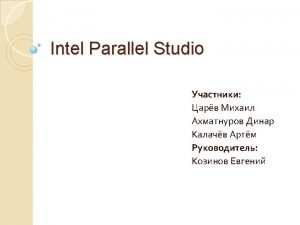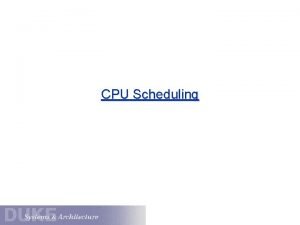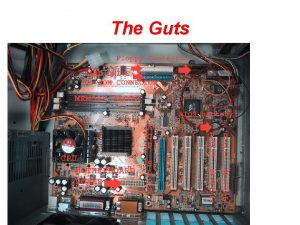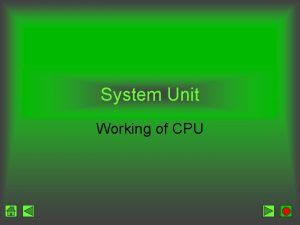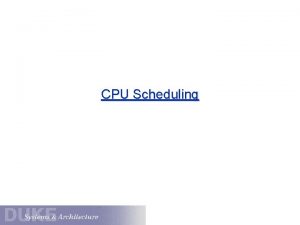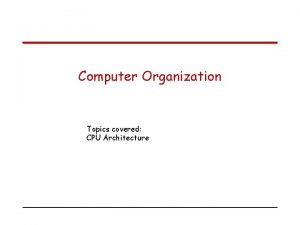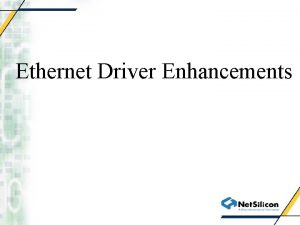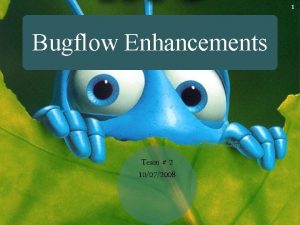CPU Performance Enhancements IT 110 Computer Organization CPU



















- Slides: 19

CPU Performance Enhancements IT 110: Computer Organization

CPU Performance Enhancements General Enhancements – Use RISC-based techniques – Fewer instruction formats, fixed-length → faster decoding – More general purpose registers → fewer memory accesses IT 110: Computer Organization

CPU Performance Enhancements Clock cycle and instruction cycle – Most instructions take several clock cycles to execute: – – – Fetch the new instruction [IF]. Decode the instruction [ID]. Execute the instruction [EX]. Access memory (if needed) [MEM]. Write back to the registers [WB]. – Each stage takes a clock cycle, so complete execution takes 5 cycles. Can we do better? IT 110: Computer Organization

CPU Performance Enhancements Clock cycle and instruction cycle – Waiting for all five stages of instruction execution to complete is like building something from start to finish. Is each instruction unique like a building? Source: http: //blog. gogrid. com/wpcontent/uploads/2009/01/house-construction. png IT 110: Computer Organization

CPU Performance Enhancements Clock cycle and instruction cycle – Or can the CPU overlap the execution of several instructions at once because they’re all similar? Or is it more like a car on an assembly line? Source: http: //media. pennlive. com/opinion/photo/car-assembly -line-art-c 348 bd 70 da 852397. jpg IT 110: Computer Organization

CPU Performance Enhancements Clock cycle and instruction cycle – Five stages of instruction execution IT 110: Computer Organization

CPU Performance Enhancements Clock cycle and instruction cycle – Five stages of instruction execution Notice that the ALU used in stage 3 is idle in stages 1, 2, 4, and 5. The same can be said for other components if they are all discrete. Underutilized hardware! IT 110: Computer Organization

CPU Performance Enhancements Clock cycle and instruction cycle – Five stages of instruction execution – Solution: offset and overlap in a pipeline. IT 110: Computer Organization

CPU Performance Enhancements Clock cycle and instruction cycle – Five stages of instruction By cycle 5, execution the CPU is executing 5 instructions at once. After this, one instruction completes every cycle. An n-stage pipelined CPU is n times faster than a non-pipelined CPU. – Solution: offset and overlap in a pipeline. IT 110: Computer Organization

CPU Performance Enhancements Clock cycle and instruction cycle – Problems with pipelining – Dependencies (register interlock)—if an instruction needs a result from the immediately preceding instruction, that result won’t be written back until WB, but the result is needed in EX. IT 110: Computer Organization

CPU Performance Enhancements Clock cycle and instruction cycle – Problems with pipelining – Dependencies (register interlock)—if an instruction needs a result from the immediately preceding instruction, that result won’t be written back until WB, but the result is needed in EX. Three solutions: forward the result from EX 1 to EX 2, introduce a stall, or reorder the instructions to eliminate the dependency. IT 110: Computer Organization

CPU Performance Enhancements Clock cycle and instruction cycle – Problems with pipelining – Branching—when the instruction being executed is a branch, we can’t know if the branch will be taken until after stage 3. But by that time, other instructions are “in flight. ” IT 110: Computer Organization

CPU Performance Enhancements Clock cycle and instruction cycle – Problems with pipelining – Branching—when the instruction being executed is a branch, we can’t know if the branch will be taken until after stage 3. But by that time, other instructions are “in flight. ” Should these two instructions execute? Not if the branch is taken. IT 110: Computer Organization

CPU Performance Enhancements Clock cycle and instruction cycle Solution: “Predict” that the branch is – Problems with pipelining not taken (allowing instructions to fly), – Branching – when the instruction being executed is a branch, we can’t know if the and then cancel them if we predicted branch will be taken until after stage 3. But by that time, other instructions are “in wrong. flight. ” IT 110: Computer Organization

CPU Performance Enhancements Superscalar Processing – RISC and pipelining lets each functional unit in a CPU be fully utilized all of the time. – But, what if there were multiple ALUs or multiple decoders? Then multiple instructions could be executed at once. – Prerequisite: Multiple instructions should be fetched at once via a large path to memory. IT 110: Computer Organization

CPU Performance Enhancements Superscalar Processing Scalar processing: only one copy of each functional unit in the CPU IT 110: Computer Organization

CPU Performance Enhancements Superscalar Processing Superscalar processing: more than one copy of each functional unit in the CPU IT 110: Computer Organization

CPU Performance Enhancements Superscalar Processing – Problems with superscalar processing – Same general categories as with pipelining: dependencies and branches – Except now forwards, stalls, or canceling may need to be between several functional units! – CPUs become very complex again, yet it is common to have 2 to 4 separate pipelines per core in modern processors. IT 110: Computer Organization

CPU Performance Enhancements Summary – RISC-based CPUs offer general performance enhancements due to simplified formats and single-clock cycle execution. – Pipelining allows multiple instructions to be in various stages of execution at once. – Superscalar processing duplicates pipelines in a single core to have multiple instructions executing simultaneously. – Data dependencies and branches are hazards to both pipelining and superscalar architectures. IT 110: Computer Organization
 Vignette mutuelle 110/110
Vignette mutuelle 110/110 000 111 000
000 111 000 Process organization in computer organization
Process organization in computer organization Herdaynote arsitektur memori
Herdaynote arsitektur memori Response time in computer architecture
Response time in computer architecture Basic structure of a computer system
Basic structure of a computer system Difference between computer organization and architecture
Difference between computer organization and architecture Design of basic computer
Design of basic computer Flow chart for interrupt cycle
Flow chart for interrupt cycle Traditionally light cured gels relied on
Traditionally light cured gels relied on Monomer liquid and polymer powder nail enhancements
Monomer liquid and polymer powder nail enhancements Advertising vs promotion
Advertising vs promotion What is the proper procedure for applying one color monomer
What is the proper procedure for applying one color monomer Cpu equation
Cpu equation Cpu performance rating
Cpu performance rating How to calculate cpu performance
How to calculate cpu performance Cpu performance
Cpu performance Cpu is the heart of computer
Cpu is the heart of computer Terminator 2 neural net processor
Terminator 2 neural net processor Ec 6009
Ec 6009



